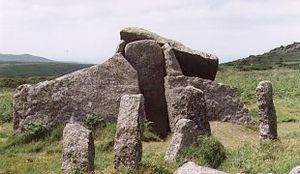Zennor Quoit facts for kids
 |
|
| Location | near Zennor and St Ives |
|---|---|
| Region | Cornwall England |
| Coordinates | 50°11′16.58″N 5°32′50.67″W / 50.1879389°N 5.5474083°W |
| Type | Dolmen |
| Site notes | |
| Condition | Ruined |
Zennor Quoit is an ancient stone structure, like a giant puzzle made of rocks, found on a moor near the village of Zennor in Cornwall, England. It is a type of dolmen, which is an old burial chamber made from large stones. This amazing monument was built a very long time ago, between 2500 and 1500 BC.
Even though its huge roof stone, weighing about 12,500 kilograms (that's like two elephants!), fell down sometime between 1770 and 1865, the rest of the chamber is still in good shape.
What Zennor Quoit Looks Like
Zennor Quoit is located on the West Penwith moors, about 1.6 kilometers east of Zennor village. You can reach it from the B3306 road, which is about 3.2 kilometers from St. Ives. From the road, a path leads to the site from a place called "Eagle's Nest."
The entire stone structure measures about 12.8 meters across. Five large stones hold up what's left of the roof. This massive roof slab is about 5.5 meters long and 2.9 meters wide. It has slipped from its original spot, with one end now resting on the ground.
The main chamber itself is made of seven tall, upright stones. It was once covered by a mound of stones and earth called a cairn. The chamber also had a small entrance area, like a porch, and an even smaller room inside.
About 300 meters to the east, you can find another ancient site called Sperris Quoit. However, it is not as well-preserved as Zennor Quoit.
The Story of Zennor Quoit
This ancient chamber was built between 2500 and 1500 BC. It is one of eight similar stone structures still standing on the West Penwith moors. Digs at the site have shown that the chamber was used for burying people. Over time, bodies were cremated (burned) and removed, making space for new burials. Archaeologists have found ancient flint tools, pottery from the Stone Age, and cremated bones here.
There's a local legend about Zennor Quoit. People say the quoit has magical powers! If someone tries to take stones away from the structure, the legend says they will mysteriously find their way back in the middle of the night.
In the 1700s, before the roof fell, a scholar named Dr. William Borlase studied the quoit. He drew detailed pictures of it and wrote about his findings in a book called Antiquities of Cornwall.
In 1861, a local farmer wanted to turn the monument into a shelter for his cows. He even started drilling holes in the roof stone! But the people of Zennor and the local church leader, William Borlase (who was a great-grandson of the earlier Dr. Borlase), were very upset. The church leader offered the farmer money to build his cowshed somewhere else, which he did. You can still see the drill holes in the stone today!
In 1882, another member of the Borlase family helped protect the quoit. During a visit by a local history group, a man shared a story. He and his son had found a flat stone under the quoit. They moved it and found another flat stone. Underneath that, they discovered an ancient whetstone. A whetstone is a tool used to sharpen weapons. People believed it was buried with the dead so they could sharpen their weapons in the afterlife. The Borlase family member had found similar stones with urns (pots) holding ashes in other ancient burial mounds. He also found part of an urn under Zennor Quoit. He hoped no one would disturb the quoit again, saying it should be respected like a family grave.
Every year, a group called the Old Cornwall Society gathers behind the chamber on Midsummer's Eve. They light a special bonfire there as part of an old tradition.
Poetry About the Quoit
Charles Taylor Stephens, who lived from 1863 in St Ives, was a shoemaker and the local postman. He wrote a poem about the time the farmer tried to turn the quoit into a cowshed. He also helped collect old folk tales from the Zennor area.
Gallery
-
Aerial plan view by Dr. William Borlase (1769)






